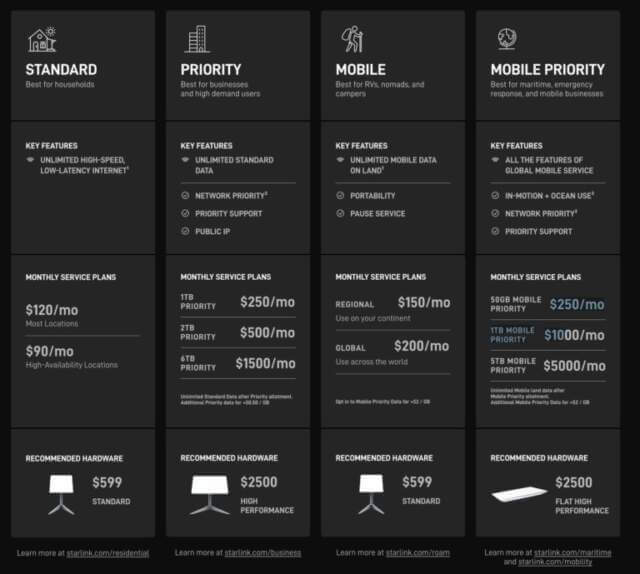Did you know that millions of people in rural America have a DSL Internet service of between 25- 40Mbps, a quarter of a million still use dial-up and 13 million don’t have Internet access at all? There are probably similar figures for other countries, predominantly rural areas, which is one of the main reasons that Starlink from SpaceX was developed in the first place. In fact, my brother, who lives in rural England, has had to endure a paltry 5Mbps – often dipping to 2Mbps – for as long as I can remember. Those of us who live in urban areas, of course, don’t have the need for Starlink since high-speed fibre optics is practically the standard nowadays.
In simple terms, the Starlink satellites in low earth orbit transmit the Internet to your satellite dish in a similar way to receiving a satellite TV signal. Still, since they are in a low orbit, the latency is much lower.
Check Starlink Coverage
The map in the picture (above) illustrates in light blue the current availability of the service and for a more detailed view, go to the Starlink map. According to the company’s website, the service is on a first-come, first-served basis so there are waiting lists. If you live in rural America, it looks like you’re covered, but oddly enough, Argentina is not covered by Starlink at all which is surprising because about 80% of the country is rural.
How Fast Is Starlink?
According to the company, typical download speeds are between 25 and 220Mbps with most users experiencing over 100Mbps. Since I’ve never used Starlink, I can’t comment on the speed or quality of its customer service, but according to Trustpilot, opinions are split. Some users are enjoying real-time speeds up to 200Mbps while others are far from happy with the customer service.
Some 20 years ago I lived in a remote location in Spain with no main electricity, water, or Internet, relying on solar panels and a wind generator. It was a challenging time and I remember using GPRS 2G for email and basic browsing – a painful and expensive experience. I mention this because I also investigated satellite Internet which was just emerging, but it was ridiculously expensive and potentially unreliable. My brother tried satellite Internet in England but kicked it into touch after a week because it simply didn’t come up to expectations. As of only a few weeks ago, he now has a 200Mbps fibre optic service, by the way.
How Much Does It Cost?
It’s important to put the cost of such a service into context. If you live in the middle of nowhere, like I did in Spain, and you don’t even see a DSL connection on the horizon, the basic package of $120 per month doesn’t sound an awful lot. You would have to add $599 for the hardware though, which is a one-off payment.
I have no doubt that if Starlink had existed back then, I would have snapped it up because there was simply no alternative. Today, the average price of broadband in the US is around $62 per month (after taxes) and very often it’s capped and may attract overage penalty charges. According to Starlink, the service is not capped and there are no such penalty charges.
Do you live in a rural area or if you did, would you consider a satellite Internet service?
—




You don’t have to be forgotten rural to get very poor reception.
I live in quarsi-rural Australia, just a few kilometers from major city areas.
And I have NBN which makes it all the worse when you read the foolwoing.
My provider has seen fit to drop my data volume to 9mbps download and .2mbps upload. It is bloody impossible to do anything.
Yet the price remains the same at $70mth. Thankfully this weekend I am moving from this property but I will not have internet at all where I am going to.
It is a little more remote but still only 35kilometers to a major town.
And it also has NBN but the blinky box is inside the kitchen which is far too close to the liveable part of the house for my comfort.
So the blinky box that brings in the NBN has to be moved before I investigate internet for that property.
So Australia also has a major deficit when it comes to the internet.
I’m calling BS!
By 2019, Census estimates put dial-up internet use at around 0.2% of households, meaning as of 2019, at least 265,000 people in the U.S. were still using dial-up for home internet access
https://www.howtogeek.com/890520/how-many-people-in-the-us-are-still-using-dial-up-internet/
And while 25 Mbs might seem rocket-fast speed to a dialup user, it seldom even allows you to stream videos without buffering. When you add your celliophone and a couple of IoT devices to the mix, you are totally flatter than a pancake.
I just tested T-mobils 5g internet and even when they Guarantee 100Mbs minimum, they not only seldom reach that 100Mbs speed, but still can’t provide reliable streaming.
I find it unbelievable that today in year 2023, the big Internet providers are not granting access to more regions other than major cities. Not sure if the government should provide some incentives, force them, or just stay out. Extremely sorry for those who have to pay outrages fees for what should be a staple allowing people Internet access, Mindblower!
I am calling BS also, unless you live on a mountain top you should have access to some sort of internet access even if it is only dial up, if you have a phone line you should have internet availability.
And in today’s day and age , $120 a month and $599 for hardware setup is EXTREMELY expensive for satellite internet access, considering one can get satellite TV for far less than that and it is basically the same setup.